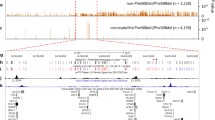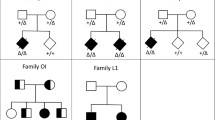Abstract
On 19q13, TGFB1 and the cystic fibrosis modifier 1 locus (CFM1) have been identified as modifiers of the course of the monogenic disease cystic fibrosis (CF). Recently, we have described a transmission disequilibrium at the microsatellite D19S197, localized between TGFB1 and CFM1. To map the corresponding molecular variants, we have selected informative SNP markers within a 600-kb area and compared two-marker-haplotype-distributions between phenotypically contrasting sib pair groups, intending to type only phylogenetically old markers by aiming for close-to-maximal polymorphism information content of the SNPs. Starting with a seed set of five SNPs that cover intermarker distances of up to 50 kb, we have iteratively added more SNPs to the map, until we could identify two genomic fragments of 3,289 and 2,052 bp for which pairs with contrasting phenotypes showed different haplotype distributions on the final 17-SNP-map (P raw = 0.0002, P corr17SNPs = 0.0106 and P raw = 0.0008, P corr17SNPs = 0.0469, respectively). Resequencing of these fragments of four unrelated individuals for each element showed that the mildly and severely affected pairs differ in seven SNPs and concordant pairs differ from discordant pairs in five SNPs. Annotation of these variants indicate that CEACAM6 and a regulatory element near the 3′ end of CEACAM3 are associated with CF disease severity and intrapair discordance, respectively. While our approach was only guided by the markers’ position, the involvement of genes from the CEACAM family in host defense and innate immunity designates these proteins as likely modifiers of the multi-organ disease cystic fibrosis which is known for its cytokine imbalance and pro-inflammatory phenotype.






Similar content being viewed by others
References
Arkwright PD, Laurie S, Super M, Pravica V, Schwarz MJ, Webb AK, Hutchinson IV (2000) TGF-beta(1) genotype and accelerated decline in lung function of patients with cystic fibrosis. Thorax 55:459–462
Barnich N, Carvalho FA, Glasser AL, Darcha C, Jantscheff P, Allez M, Peeters H, Bommelaer G, Desreumaux P, Colombel JF, Darfeuille-Michaud A (2007) CEACAM6 acts as a receptor for adherent-invasive E. coli, supporting ileal mucosa colonization in Crohn disease. J Clin Invest 117:1566–1574
Becker T, Knapp M (2004) A powerful strategy to account for multiple testing in the context of haplotype analysis. Am J Hum Genet 75:561–570
Becker T, Jansen S, Tamm S, Wienker TF, Tümmler B, Stanke F (2007) Transmission ratio distortion and maternal effects confound the analysis of modulators of cystic fibrosis disease severity on 19q13. Eur J Hum Genet 15:774–778
Blackman SM, Deering-Brose R, McWilliams R, Naughton K, Coleman B, Lai T, Algire M, Beck S, Hoover-Fong J, Hamosh A, Fallin MD, West K, Arking DE, Chakravarti A, Cutler DJ, Cutting GR (2006) Relative contribution of genetic and nongenetic modifiers to intestinal obstruction in cystic fibrosis. Gastroenterology 131:1030–1039
Bremer LA, Blackman SM, Vanscoy LL, McDougal KE, Bowers A, Naughton KM, Cutler DJ, Cutting GR (2008) Interaction between a novel TGFB1 haplotype and CFTR genotype is associated with improved lung function in cystic fibrosis. Hum Mol Genet 17:2228–2237
Bronsveld I, Mekus F, Bijman J, Ballmann M, de Jonge HR, Laabs U, Halley DJ, Ellemunter H, Mastella G, Thomas S, Veeze HJ, Tümmler B (2001) Chloride conductance and genetic background modulate the cystic fibrosis phenotype of Delta F508 homozygous twins and siblings. J Clin Invest 108:1705–1715
Callaghan MJ, Rockett K, Banner C, Haralambous E, Betts H, Faust S, Maiden MC, Kroll JS, Levin M, Kwiatkowski DP, Pollard AJ (2008) Haplotypic diversity in human CEACAM genes: effects on susceptibility to meningococcal disease. Genes Immun 9:30–37
Corey M, Farewell V (1996) Determinants of mortality from cystic fibrosis in Canada, 1970–1989. Am J Epidemiol 143:1007–1017
Dean NL, Loredo-Osti JC, Fujiwara TM, Morgan K, Tan SL, Naumova AK, Ao A (2006) Transmission ratio distortion in the myotonic dystrophy locus in human preimplantation embryos. Eur J Hum Genet 14:299–306
Dorfman R, Sandford A, Taylor C, Huang B, Frangolias D, Wang Y, Sang R, Pereira L, Sun L, Berthiaume Y (2008) Complex two-gene modulation of lung disease severity in children with cystic fibrosis. J Clin Invest 118:1040–1049
Dorfman R, Li W, Sun L, Lin F, Wang Y, Sandford A, Paré PD, McKay K, Kayserova H, Piskackova T, Macek M, Czerska K, Sands D, Tiddens H, Margarit S, Repetto G, Sontag MK, Accurso FJ, Blackman S, Cutting GR, Tsui LC, Corey M, Durie P, Zielenski J, Strug LJ (2009) Modifier gene study of meconium ileus in cystic fibrosis: statistical considerations and gene mapping results. Hum Genet (in press)
Drumm ML, Konstan MW, Schluchter MD, Handler A, Pace R, Zou F, Zariwala M, Fargo D, Xu A, Dunn JM, Darrah RJ, Dorfman R, Sandford AJ, Corey M, Zielenski J, Durie P, Goddard K, Yankaskas JR, Wright FA, Knowles MR, Group Gene Modifier Study (2005) Genetic modifiers of lung disease in cystic fibrosis. N Engl J Med 353:1443–1453
European Working Group on Cystic Fibrosis Genetics (1990) Gradient of distribution in Europe of the major CF mutation and of its associated haplotype. Hum Genet 85:436–445
Fick RB Jr, Sonoda F, Hornick DB (1992) Emergence and persistence of Pseudomonas aeruginosa in the cystic fibrosis airway. Semin Respir Infect 7:168–178
Herold C, Becker T (2009) Genetic association analysis with FAMHAP: a major program update. Bioinformatics 25:134–136
Knapp M, Becker T (2003) Family-based association analysis with tightly linked markers. Hum Hered 56:2–9
Kolla V, Gonzales LW, Bailey NA, Wang P, Angampalli S, Godinez MH, Madesh M, Ballard PL (2008) Carcinoembryonic cell adhesion molecule 6 in human lung: regulated expression of a multifunctional type II cell protein. Am J Physiol Lung Cell Mol Physiol 296:L1019–L1030
Kuespert K, Pils S, Hauck CR (2006) CEACAMs: their role in physiology and pathophysiology. Curr Opin Cell Biol 18:565–571
Kumar V, Becker T, Jansen S, van Barneveld A, Boztug K, Wölfl S, Tümmler B, Stanke F (2008) Expression levels of FAS are regulated through an evolutionary conserved element in intron 2, which modulates cystic fibrosis disease severity. Genes Immun 9:689–696
Larriba S, Sumoy L, Ramos MD, Giménez J, Estivill X, Casals T, Nunes V (2001) ATB(0)/SLC1A5 gene. Fine localisation and exclusion of association with the intestinal phenotype of cystic fibrosis. Eur J Hum Genet 9:860–866
Lowe CB, Bejerano G, Haussler D (2007) Thousands of human mobile element fragments undergo strong purifying selection near developmental genes. Proc Natl Acad Sci USA 104:8005–8010
Mekus F, Ballmann M, Bronsveld I, Bijman J, Veeze H, Tümmler B (2000) Categories of deltaF508 homozygous cystic fibrosis twin and sibling pairs with distinct phenotypic characteristics. Twin Res 3:277–293
Mekus F, Laabs U, Veeze H, Tümmler B (2003) Genes in the vicinity of CFTR modulate the cystic fibrosis phenotype in highly concordant or discordant F508del homozygous sib pairs. Hum Genet 112:1–11
Riordan JR (2008) CFTR function and prospects for therapy. Annu Rev Biochem 77:701–726
Rozmahel R, Wilschanski M, Matin A, Plyte S, Oliver M, Auerbach W, Moore A, Forstner J, Durie P, Nadeau J, Bear C, Tsui LC (1996) Modulation of disease severity in cystic fibrosis transmembrane conductance regulator deficient mice by a secondary genetic factor. Nat Genet 12:280–287
Santangelo AM, deSouza FS, Franchini LF, Bumaschny VF, Low MJ, Rubinstein M (2007) Ancient exaptation of a CORE-SINE retroposon into a highly conserved mammalian neuronal enhancer of the proopiomelanocortin gene. PLoS Genet 3:1813–1826
Schmitter T, Agerer F, Peterson L, Munzner P, Hauck CR (2004) Granulocyte CEACAM3 is a phagocytic receptor of the innate immune system that mediates recognition and elimination of human-specific pathogens. J Exp Med 199:35–46
Sharma R, Florea VG, Bolger AP, Doehner W, Florea ND, Coats AJ, Hodson ME, Anker SD, Henein MY (2001) Wasting as an independent predictor of mortality in patients with cystic fibrosis. Thorax 56:746–750
Stanke F, Tümmler B, Becker T (2006a) Genetic modifiers in cystic fibrosis. N Engl J Med 354:88–90
Stanke F, Becker T, Cuppens H, Kumar V, Cassiman JJ, Jansen S, Radojkovic D, Siebert B, Yarden J, Ussery DW, Wienker TF, Tümmler B (2006b) The TNFalpha receptor TNFRSF1A and genes encoding the amiloride-sensitive sodium channel ENaC as modulators in cystic fibrosis. Hum Genet 119:331–343
Strachnan T, Read AP (1996) Molekulare Humangenetik. Spektrum Akademischer Verlag, Heidelberg, pp 373–376
Strausbaugh SD, Davis PB (2007) Cystic fibrosis: a review of epidemiology and pathobiology. Clin Chest Med 28:279–288
Xie X, Kamal M, Lander ES (2006) A family of conserved noncoding elements derived from an ancient transposable element. Proc Natl Acad Sci USA 103:11659–11664
Zielenski J, Corey M, Rozmahel R, Markiewicz D, Aznarez I, Casals T, Larriba S, Mercier B, Cutting GR, Krebsova A, Macek M Jr, Langfelder-Schwind E, Marshall BC, DeCelie-Germana J, Claustres M, Palacio A, Bal J, Nowakowska A, Ferec C, Estivill X, Durie P, Tsui LC (1999) Detection of a cystic fibrosis modifier locus for meconium ileus on human chromosome 19q13. Nat Genet 22:128–129
Zielenski J, Markiewicz D, Yuan X, Patel M, Sun L, Liu X, Aznarez I, Tsui L, the CF Modifier Study Consortium (2003) Enhanced haplotype association analysis for the identification of the cystic fibrosis modifier 1 gene using additional genetic markers in the region containing KCNN4. Pediatric Pulmonol S25:93
Zielenski J, Dorfman R, Markiewicz D, Corey M, Ng P, Mak W, Durie P, Tsui L (2005) Tagging SNP analysis oft he CFM1 locus in CF patients with and without meconium ileus. Pediatric Pulmonol S28:168
Acknowledgments
The study was supported by a grant from the Deutsche Forschungsgemeinschaft (DFG, SFB621-C7). The authors would like to thank an anonymous reviewer for helpful and constructive comments.
Conflict of interest statement
The authors do not have any conflict of interest.
Author information
Authors and Affiliations
Corresponding author
Electronic supplementary material
Below is the link to the electronic supplementary material.
Rights and permissions
About this article
Cite this article
Stanke, F., Becker, T., Hedtfeld, S. et al. Hierarchical fine mapping of the cystic fibrosis modifier locus on 19q13 identifies an association with two elements near the genes CEACAM3 and CEACAM6 . Hum Genet 127, 383–394 (2010). https://doi.org/10.1007/s00439-009-0779-6
Received:
Accepted:
Published:
Issue Date:
DOI: https://doi.org/10.1007/s00439-009-0779-6




